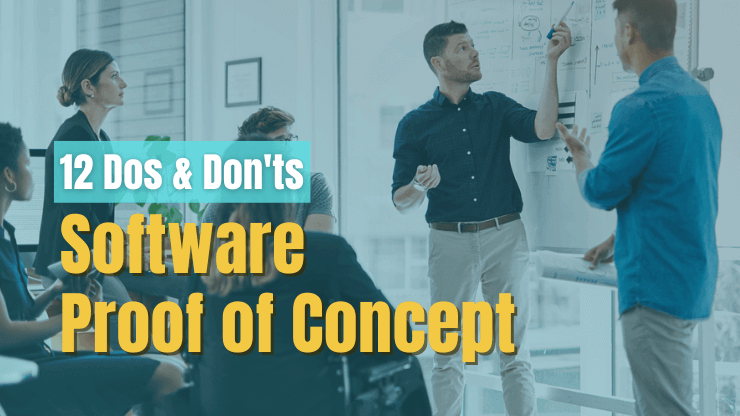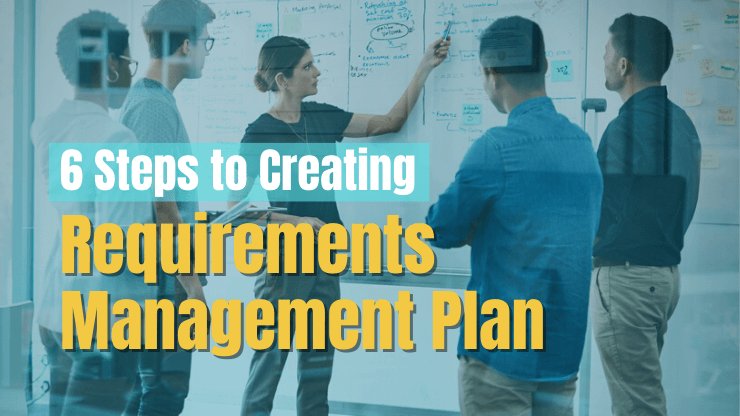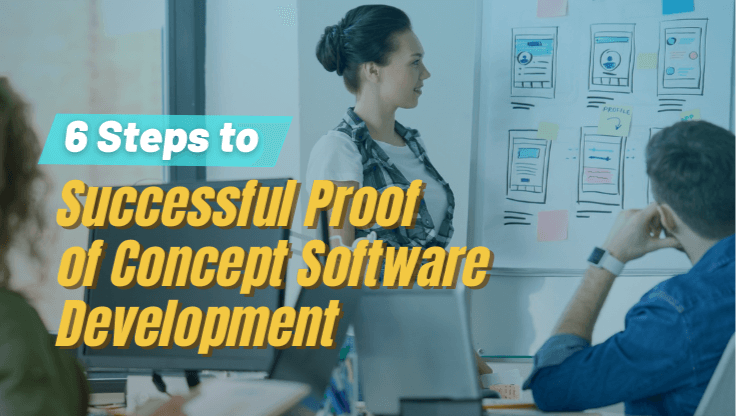66% of software projects fail to meet their intended objectives. This can cost organizations heavily in terms of drained resources, wasted time, missed market opportunities, and, most even compromised reputations.
A software PoC, at its core, is a litmus test for your project's technical feasibility and its alignment with user expectations. A well-executed Proof of Concept (PoC), to mitigate these risks and steer their software projects towards success.
In this article, we will offer 12 dos and don’ts to help you navigate the PoC software development process, so you can effectively validate your product idea and ensure project success.
Why is a software development PoC important?
A proof of concept is important in software development projects because it gives developers and startup teams a way to test their ideas before committing to a large project.
A software proof of concept can help you:
- Test a new business idea, model or strategy
- Validate if a software idea is worth pursuing further
- See if a software concept is technically feasible
- Identify potential risks of a software project
- Get feedback from intended users and/or the target audience
Software PoC vs MVP
There are a lot of terms thrown around when it comes to the software development process, and it can be confusing to keep track of all of them. PoC is often conflated with an MVP (minimum viable product), but they are actually distinctly different phases of the product development or software development lifecycle. Let’s take a look at some of the key differences of a PoC vs MVP:
In practice, a proof of concept is typically an internal project built during an early product development stage to help validate the feasibility of further development, while an MVP should be used to deliver the core features of your product to real, external target users.
Software Proof of Concept - Dos
A PoC can help reduce the risks of the software development process and allow teams to vet an idea before further investment, but it’s important to follow the tips in this section to ensure your proof of concept is able to effectively fulfill its goals.

1. Be clear on your business goals
Every PoC project should begin by aligning on the business goals. The beauty of a PoC is that it can come in many forms and help teams achieve many different forms of validation. But this also means it is critical to ensure there are no assumptions being made about the PoC goals, and instead that they are clearly defined and agreed upon amongst the stakeholders.
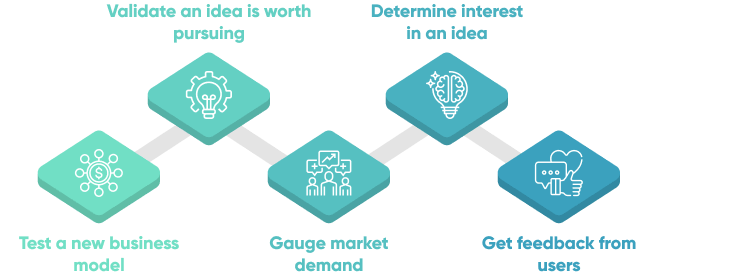
If you’re unsure what goals a successful proof of concept could achieve, consider that it could be used to:
- Test a new business model or strategy
- Validate a software idea is worth pursuing further
- Gauge demand within the target market
- Determine interest in a new or original idea
- Get initial feedback from target users
Some teams may find that they meet their goals in phases. A PoC could help to validate the feasibility of the project. A later prototype could help to validate technical risks and generate target users' feedback.
PRO TIP: Did you know that businesses lose an average of 20-30% of their revenue due to inefficient business processes? That's a lot of money left on the table. One of the best ways to get control of this lost revenue is through business process mapping. With the right business process maps, you can identify inefficiencies and fix them, fast.
Read More: 6 Truly Essential Business Process Mapping Examples
2. Take the time to understand users
As with any product development process, you need to put the users at the center of your PoC project. Understanding your users, their needs, preferences, and pain points will help you solidify your PoC and ensure your software developers have a clear understanding of the project goals.
To understand your users, consider:
- Engaging with your target market: Start by interacting with potential users to learn their needs, goals, and daily challenges. Observe them in their environment to gain insights into their habits and pain points. Use these observations to shape a user-focused PoC (and ultimately a user-focused software product).
- Surveying potential users: Surveys provide a wider view of your target market. Don't just focus on your product; explore your users' overall experiences. Discover their interests, main concerns, pain points, and favorite web apps. Use this feedback to align your PoC with users' needs and preferences.
PRO TIP: To maximize the effectiveness of surveys and interviews with potential users, utilize a user or customer feedback tool to systematically gather input. If you’re looking to get more detailed feedback as part of an interview or survey, consider a tool like usersnap that allows users to tag specific areas of the software that they want to comment on. This can work well if you are replacing an existing software or want to understand how users utilize similar software tools to what you are going to build.

3. Embrace validated learning
Embrace validated learning, where the software development team is encouraged to push forward, quickly testing new ideas and implementation tactics, rather than spending more time finding a “perfect” solution, can help you expedite the development process and achieve a successful PoC faster.
This mindset not only conserves resources by helping you identify and abandon ineffective strategies early but also promotes rapid learning, drives innovation, and can speed up your product's time-to-market. The goal is to make small, low-risk tests from which you can learn from quickly, rather than making large, costly mistakes.

Here are the key ways to implement this philosophy:
- Avoid creating a work environment where failure is feared. Encourage a culture of psychological safety to stimulate creativity and risk-taking.
- Establish clear metrics and KPIs to measure success or failure and enable early course correction.
- Maintain open communication about progress, successes, and failures to learn collectively and pivot promptly.
4. Test your idea with a prototype
Use rapid prototyping techniques instead of spending extensive time on detailed prototypes, focus on creating quick and basic prototypes.
Your prototype doesn’t need to be a highly polished, functionally rich finished product, merely something that allows you to test and validate (or dispel) your assumptions. Your goal should be to test the functionality of major product features, not test design elements.
It is often said of prototypes that the organization should be at least “a little bit embarrassed” to release them to the public, which means that, if everything works 100% then there has been too much effort put into productionising the prototype before its release.
PRO TIP: At SoftKraft we use interactive prototypes that allow us to run user testing early as part of our UX / UI Design Services process.
Each prototype has embedded information that allows distributing it to distribute it withing organiztion and request participants to record thor interaction with it i.e. using Google Meet.
Based user test recordings, we are able to create a map of the user feedback that can be used to improve the solution in next iteration and rerun the test. Here is how this map looks like:
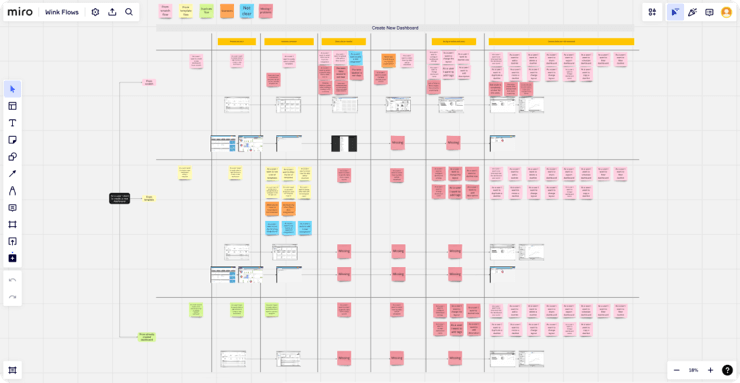
5. Find the right software partner
Choosing the right software partner for your PoC development is crucial. Finding a software development partner might seem a little intimidating at first, in part due to the vast number of software development companies ready to deliver their services. However, the realsity is the best tech talent is busy. That is why you need to be prepared to put effort into finding a good development partner and solid talent that is available at a reasonable timeframe.
An effective software partner demonstrates a commitment to understanding your requirements, as reflected in their interaction with you. Their questions should indicate they're striving to align with your business needs, leading to a PoC software solution tailored to your objectives. Their understanding and ongoing support will play a critical role in driving your software proof of concept to success.

PRO TIP: Finding the right partner early on can smooth the path from concept to a fully developed project, ensuring a seamless transition. This partner can assist you in transitioning from a PoC to a formal prototype or MVP for your new software development project.
Read More: How to Choose a Software Development Company in 10 Steps.
6. Use existing technology components
When developing a proof of concept (and later your prototypes or MVP), reusing existing technology components can prove to be a significant efficiency booster. It not only saves time and resources but also leverages tested and reliable components, reducing potential points of failure. Your team can do this by following these steps:
- Conduct an inventory: Start by making an inventory of the existing technology components that are available to you. This could include code libraries, APIs, software modules, and more.
- Evaluate and select: Not all components will be useful or suitable for your project. Evaluate each one for its compatibility with your proof of concept objectives and technical requirements. Choose those that align with your needs.
- Plan integration: Once you have selected the components, plan how they will be integrated into your proof of concept. Ensure you have the right expertise on hand to handle any necessary customization or adaptation.
Software Proof of Concept - Don’ts
In the last 15 years of helping businesses with the proof of concept development process, we’ve identified some common pitfalls that businesses experience in this process. In this section, we explore some of these, so you can avoid them and ensure you have a successful outcome with your own proof of concept project.

1. Include more features than necessary
A common pitfall during the development of a proof of concept is the temptation to include more features than necessary. The main objective of a PoC is to demonstrate the feasibility of your core idea, not to present a feature-complete product.
Adding too many features can dilute this focus, consume more resources, and unnecessarily prolong the proof of concept project. Instead, aim for a lean, focused proof of concept that revolves around the basic functionalities needed to validate your core concept. As the proof of concept proves successful and progresses to further development stages, additional features can be introduced and tested based on user feedback and your larger business plan.

2. Get too attached to an initial idea
The process of developing a proof of concept starts with an initial idea, a hypothesis to be validated and refined. However, it's crucial to avoid becoming too attached to this initial brainchild. Being overly committed can hinder the product's evolution, potentially restricting adaptability based on user feedback, technical feasibility, or changing market dynamics.
3. Ignore non-functional requirements
When developing a PoC, it can be tempting to focus only on the functional requirements – the features that directly address user needs and visible product behavior. But non-functional requirements are just as important.
Non-functional requirements should describe _how _a software system works. The end result of non-functional requirements will be product attributes that may be more “behind the curtain”, such as those related to:
- Security. Does your company have any specific security standards that should be adhered to during the development of this software product?
- Compatibility. Will the proposed software system be able to integrate smoothly with existing systems and applications within the organization?
- Scalability. What is the maximum load that should be able to be handled? Consider both data and user traffic.
- Usability. This addresses the ease of use and learnability of the system or product. Does the software need to be intuitively understandable, or does it cater to an expert niche?
PRO TIP: Use a proof of concept template to document your project requirements, validate them with key stakeholders, and manage the development and testing process.

4. Overcomplice the technology stack
Selecting the right technology for your software proof of concept is instrumental in its success, but remember, simplicity is key. The aim of your PoC is to demonstrate the viability of your concept, not to become a full-fledged software product that’s ready for real users in your target market.
Firstly, your technology choice should align with your PoC's goals and the approach you've identified. Keep in mind the audience who will interact with your proof of concept— their needs and expectations should guide your selection. Lastly, be mindful of your budget. Unlike a MVP, it's not necessary for a PoC to evolve into the final product, so going for the most cost-effective option that meets your needs is often the best choice.
5. Wait too long to get user feedback
Obtaining early user feedback is crucial when developing a PoC. The earlier you involve users, the better you can understand their needs, expectations, and potential difficulties with the proposed solution.
If you wait too long to seek user feedback, you risk investing significant time and resources into aspects of the PoC that may not align with user needs or expectations. Early feedback allows for swift course corrections, helps shape the PoC in line with user requirements, and increases the chances of end-user acceptance and adoption.
Here are some strategies to gather user feedback:
- Surveys and questionnaires: Develop structured questionnaires or surveys to gather feedback on specific aspects of your proof of concept.
- Focus groups: Arrange focus group sessions where a small group of users can explore the PoC and provide feedback.
- User interviews: Conduct one-on-one interviews with potential users for in-depth insights into their expectations and potential concerns.
- Usability tests: Allow users to interact with the proof of concept and observe their behavior, difficulties, and how intuitively they can complete tasks.

6. Forget about documentation
In the rush to develop a proof of concept, documentation can sometimes take a backseat. However, thorough documentation is fundamental for successful project management and transition from a PoC into minimum viable product development or prototyping.
Documentation helps ensure that the core ideas, design decisions, and insights gained during the PoC stage are not lost over time or during team transitions. It sets up a clear path for future development, helps maintain consistency, and aids in knowledge transfer among team members.
Here are some key areas that should be documented during PoC development:
- Design decisions: Track and document your design decisions, including the reasoning behind them. This can provide valuable context for future developers or stakeholders and maintain design consistency.
- Technical architecture: Document your technology stack, system architecture, database design, and any APIs or third-party services used.
- Test results: Any testing performed during the PoC stage, including usability tests, performance tests, and user acceptance tests, should be documented, along with their results and any actions taken in response.
- Challenges and lessons learned: Every project encounters obstacles. Documenting these challenges, how they were addressed, and any insights gained can guide future project planning and risk management.
Conclusion
A well-executed, software proof of concept is crucial in ensuring the success of any software development project. Adhering to these 12 do's and don'ts can help teams better navigate the PoC process, successfully validate their product idea, and increase their chances of project success.
At SoftKraft, we provide PoC software development services. We’ll help you sort out your ideas, develop a basic PoC and then move right into developing an MVP to help get your product to market faster. Reach out for a free quote!

